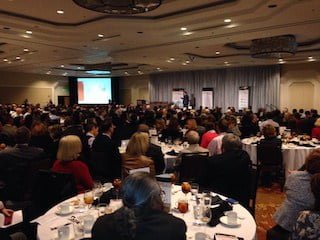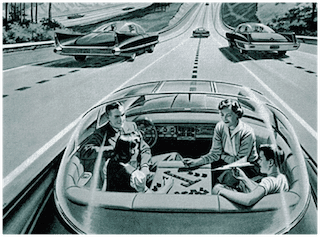There can’t be a more exciting industry in the world today than what is happening with the marriage of automotive/transport technology to Silicon Valley. And it’s a a trend I’ve previously reported on here ; there are a few blog references at the end of this blog post.

That’s why I was thrilled to be the opening keynote for the Colorado Transportation Department “Transportation Matters” summit last month.
It was a get together of state politicians, civic and municipal officials, economic development folk who have a vested interest in the evolution of the overall transit infrastructure in the state. (The co-sponsor was the Denver Chamber of Commerce.) These are a group of people who spend their time thinking about what they need to do to ensure that the state can stay competitive in a fast changing future.
It’s a hot topic — there was a sellout crowd of over 500 people in the room; original plans called for an audience of about 325!
My goal was to give the audience of view of what’s coming — and more importantly, how quickly it is coming — with all kinds of autonomous vehicle technology. And of course, there’s a lot going on — drone helicopters, Google’s self-driving car, Audi’s and Volvo’s own efforts with autonomous vehicle technology. Everywhere you look, there are new announcements, which is why this will be one of the hottest areas for innovation, business model disruption, new thinking, and big infrastructure investments in the decade to come.
To put these trends into perspective, I broke my keynote down into five key sections:
- bold thinking
- the velocity of change
- the hype vs. reality
- elements of progress
- the impact of generations
1. Bold thinking
One thing I try to get across to every audience is that in every industry today, we live in a period of transformative change — whether it is Tesla Motors disrupting the auto industry, personalized healthcare based on DNA, or the impact of precision farming in agriculture — we live in a period of very dramatic change.
To emphasize the concept of ‘transformation,’ I found this brilliant quote during my research
“It’s amazing: If you were an archeologist and you dug up a 1900 vintage car and you dug up a 2000 vintage car, you’d look at it, you’d say they have the same DNA, the same fundamental design DNA. Mechanically driven energy from oil, powered by combustion, controlled mechanically and hydraulically, driven by a person, operated pretty much independently.”
And what’s exciting right now is that we see a new DNA, a new design DNA for the automobile beginning to mature, electrically driven in addition to mechanically driven. Using diverse sources of energy, which can be in the form of electricity or hydrogen on board the vehicle as well as fossil fuels. Having the vehicle operate with electric motors. Very importantly, being able to control it digitally or electronically. And literally having cars that can drive themselves.
Future Car: Accelerating the Future
10 Nov 2014, IEEE Spectrum
Think about the context of that observation. Essentially, when it comes to vehicle technology – cars, trucks, you name it — we’ve essentially had the same architecture for 100 years. But all that is now changing, and it is changing at a furious speed.
2. Silicon Valley velocity
My second point is perhaps the most significant trend impacting transportation today – and that is that there is a very real shift in the innovation driver from traditional auto companies in Detroit, Germany, Japan — to Silicon Valley.
Vehicles are essentially becoming large, sophisticated computers on wheels. The challenge is that Ford, Mercedes and Honda have never been in the computer industry, and know very little about computer interface design issues. The result is that we end up with these dashboards with clunky interfaces, disgraceful methods of interaction, and design that is simply a dog’s breakfast of something thrown together at the last moment. Contrast that to the dashboard and interactive user experience of a Tesla Motors vehicle — a car essentially designed by a computer company….
I reported on this at length in a post from 2013, “Trend: The Future of Automotive and Automotive Retail”, which you can read here. I don’t see much has changed since then.
What does this shift to Silicon Valley mean? New dashboard technologies, power sources and power storage tech, intelligent highway technologies — all the stuff that goes into autonomous and 21st century vehicle technology — will increasingly emerge ‘in the Valley.’ And anyone in tech knows that hi-tech companies innovate a lot faster than any other industry. This is a pretty profound and significant shift — automotive companies are going to find that increasingly they are in a world in which ‘the future belongs to those who are fast.’ If they can’t keep up, then their product lines will become increasingly obsolete, out of date, and uncompetitive.
With this shift comes a major change to the concept of road and highway infrastructure — as all matter of sophisticated intelligent infrastructure takes over.
And my challenge to the folks in the room was this — as people responsible for economic development, are you placing yourself at the nexus of the ‘transformers’ (incubators, startup hubs, etc…) in terms of the transport revolution? Because that’s where you will find job growth, economic growth, infrastructure growth….
3. The discordance of hype vs. reality
Having said that, I challenged my audience to think about to carefully manage the difference between the hype that can come from a fast future – and the reality of what is occurring.

I spoke, for example, of Elon Musk (found of Tesla, Space-X) and his much-discussed Hyperloop ….. and I ran through a variety of headlines such as “Morgan Stanley predicts the death of the automotive industry as we know it” (BusinessInsider, October 2014, read it here). Maybe things can be hyped a little bit too much, I cautioned…….. the challenge with anything having to do with the technology industry quickly becomes, as everyone has learned, subjected to the hyper-building-hype echo chamber that is Silicon Valley.
I pointed this out, because with the hype can easily come suspicion that perhaps the trend is too over-hyped, and won’t become real any time soon.
To solve that dilemma, I ran through a series of slides I originally used when I spoke to a senior leadership team at NASA, in a talk that focused on the transformation of the business of space — by taking them back to the 1920’s and 1930’s when people were discounting the idea that mankind would ever venture into the heavens. To do that, I used a whole series of slides from Popular Mechanix and other magazines of the time.
I bloggged extensively on that talk for NASA — you can see the original magazine photos and articles here.
The point? The future always happens — the rest is just timing.
4. Elements of progress
By this point, I was working with the audience to help them realize that we live in transformative times, that the pace of change is accelerating because the technology industry is now driving the speed of change in the auto industry, but as the future unfolds, we should carefully manage the hype that comes with that.
With that as a solid foundation, I began to cover the very real advancements that are occurring with the concept of autonomous vehicle technology. These include such things as:
- collision avoidance
- pedestrian and object detection
- spatial awareness and GPS
- V2V (Vehicle to Vehicle) communications for lane, distance, time compression
- remote vehicle control
- predictive fuel efficiency routing
- intelligent highway technology – adaptive traffic light, connective flow control, etc.
The thing is — all of this is happening really fast. I used a quote from Google’s UK Automotive Chief, Hugh Dickerson:
“Today is the slowest day of technological change for the rest of your life — it is only going to get quicker”
How fast are things changing? I then noted this great great statistic:
“Connected cars are expected to generate $131.9 billion by 2019 with a compound annual growth rate (CAGR) of 34.7% from 2013 to 2019.”
Connected Cars: Legal Hurdles and Issues Monitor Worldwide. Oct 2014
Here’s something to think about: it is said that today the typical pilot, whether for an airline or flying privately, spends just about 14 minutes actually flying the plane. The rest of the time is autonomous — autopilot technology. That’s the reality of what we are headed for, one day, with ground based vehicle transportation. Remember — the future happens. The rest is just timing.
5. Generations
Finally, I closed out with the observation that the biggest trend to impact the auto industry is the arrival of the next, connected generation of drivers. My sons are now 19 and 21; they have never known a world without the Internet. Like everyone in their generation, their entire view into the world is through data and their mobile devices. As transportation changes, they will drive the change and acceptance of that generation faster than any generation before them.
It was a fun talk, and drew a great response, with this comment back from one of the key organizers:
People were really excited and energetic. I got comments about your presentation and the day as a whole like “home run” and “perfect.” One person said they had seen a futurist speak before and it was “blah blah technical and boring” and wasn’t particularly looking forward to your presentation- and they were “blown away.”…..I think many people walked in thinking they were going to get boring policy, and while we gave them a few doses of that for good measure, your presentation was policy in a thought provoking way- and with the focus on the future and technology, the Denver Chamber of Commerce will surely see this as a great “jumping off point” to their broader transportation conversation.




GET IN TOUCH
Jim's Facebook page
You'll find Jim's latest videos on Youtube
Mastodon. What's on Jim's mind? Check his feed!
LinkedIn - reach out to Jim for a professional connection!
Flickr! Get inspired! A massive archive of all of Jim's daily inspirational quotes!
Instagram - the home for Jim's motivational mind!